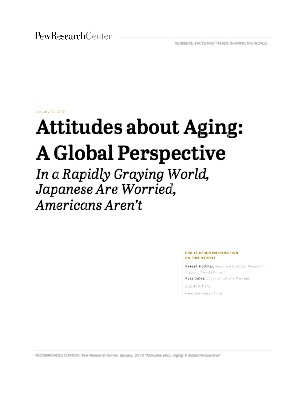by Karen Newcombe
The Pew Research Center has issued a new report on attitudes about the world's aging population. The full report is a free download, and has data on public opinion, aging in the U.S. and other countries, population changes from 1950 to 2050, and how aging populations will affect social insurance systems.
We think of the U.S. as having a large contingent of aging Boomers, whose exit from the workplace will have tremendous impact on business over the next 20 years, but it's interesting to see that China, Japan, South Korea, Germany, Spain and others are aging more rapidly that the U.S. As usual, Pew comes up with fascinating data that is of practical use to businesses.
Attitudes about Aging: A Global Perspective contains extremely interesting data, including the projection that India will surpass China in population before 2050. Other countries whose numbers of young people are growing rapidly are Nigeria, Kenya, Pakistan, Israel, and Egypt. The change in population of Italy, Russia, Germany, and Japan is expected to drop into the negative numbers.
Why is this data important to business?
The general aging of population around the world affects the numbers of people who are available to the workforce. In the U.S. we know that many in the Boomer generation plan to work longer than the previous generation, but they – and their knowledge of business – won't remain available forever. At some point they will leave the workforce, meaning more competition for the best new talent.
An aging population means that the largest group of people with disposable income are not in the coveted teen market. While teens and twenty-somethings are prized by producers of consumer goods for their tendency to all go out and buy the same hot products, the people who currently have the biggest incomes are the late Boomers and early Generation Xers, born between 1955 and 1983. Businesses focused on consumers may find it advantageous to figure out ways to market to these groups, whose tastes have diverged as they've matured.
Other considerations arise at a more day-to-day level. At the age of 40, everyone's eyesight begins to lose the ability to focus well at short distances. Marketing and advertising aimed at anyone over 40 should take into consideration the legibility of their collateral materials. The minuscule light gray fonts that are highly popular right now, and colored lettering on toned backgrounds are disastrous choices if you expect someone over 40 to be influenced by your campaign.
These three examples may seem obvious, yet working out how to deal with them proactively in your strategic action plan or marketing plan can take time, research and quite a bit of brainstorming.
Pew Research Center always has interesting surveys and statistics, and useful information. Stop by their site and see what they have available that could impact your planning in 2014.

